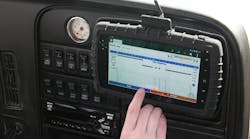Like many of us, I’ve been highly interested in the industry’s reaction to the federal electronic Iogging device (ELD) mandate after it went into effect. Have carriers been prepared, or are some of them still stalling or unclear on the requirements? What challenges has enforcement faced out in the field?
Recently, I had the opportunity to speak with several law enforcement agencies as well as other industry participants regarding the issues that have surfaced since the ELD mandate became the official rule on December 18, 2017.
Here is what I learned:
- One state police agency has yet to conduct training. While a training module for enforcement purposes was released and “train the trainer” courses were held in middle to late November, training of the rank and file has yet to happen. This is due in part to the difficulty in getting everyone in one place for training, and the fact that the mandate went into effect so close to the holidays. As a result, training has been postponed.
- Another law enforcement official stated that each enforcement official received two enforcement manuals. That is a lot of reference material to digest in such a short period of time. The officer also said inspectors who only perform roadside inspections will learn at a faster pace than officers whose primary function is normal highway patrol responsibility and secondary function is performing Level 2 inspections on violators of the rules of the road. This officer speculated it would be the middle of summer 2018 before all enforcement personnel are comfortable with the facets of the mandate and the proper way to achieve enforcement.
- Several industry members spoke about larger carriers that have had ELDs in place for some time. As a result they are having less difficulty with the mandate than others who waited until the last minute to install the devices.
- One industry member said there is a definite correlation between the type of device being used and its ability to work fast enough so that co-drivers can use the same device. She indicated that log off time is delayed and the devices currently being used must be replaced.
- An enforcement officer said that a major concern is the technology involved and the user's ability to understand how to transfer files from one device to another. He stated that they have had drivers hand the instruction manual to the officer and asked them to figure out the process. The result? Frustration on both sides.
- Another industry member stated that myths regarding Hour of Service (HOS) still are having an impact on ELD use. He saw a driver sitting in the truck after performing a pre-trip on a trailer. The driver said that it was expected that a pre-trip should take at least 30 minutes. Therefore, he needed to sit for 15 minutes before he could drive.
- Hand-held devices such as cell phones and tablets are another concern because neither the driver nor the enforcement officer are convinced that this type of device meets the criteria established by the regulations.
As you can see, there is a great deal of work to be done on both sides of the ELD issue. In every discussion of ELDs, the subject of HOS is brought up. It is important to keep in mind that the ELD mandate did not change the provisions of the HOS regulations. Discussions about ELDs need to be divorced from concerns about HOS.
I believe many of the HOS/ELD concerns are coming forward because of the lack of understanding of HOS prior to the ELD mandate. The focus on ELD is serving as the impetus to educate many about the who, what and when of the HOS rules. Furthermore, I believe enforcement needs to take a reasonable approach on enforcement actions, and use this as an educational opportunity. Industry needs to step up and take on the responsibility of truly educating their drivers. Together, the motor carrier industry and enforcement can continue to make our highways safer.



